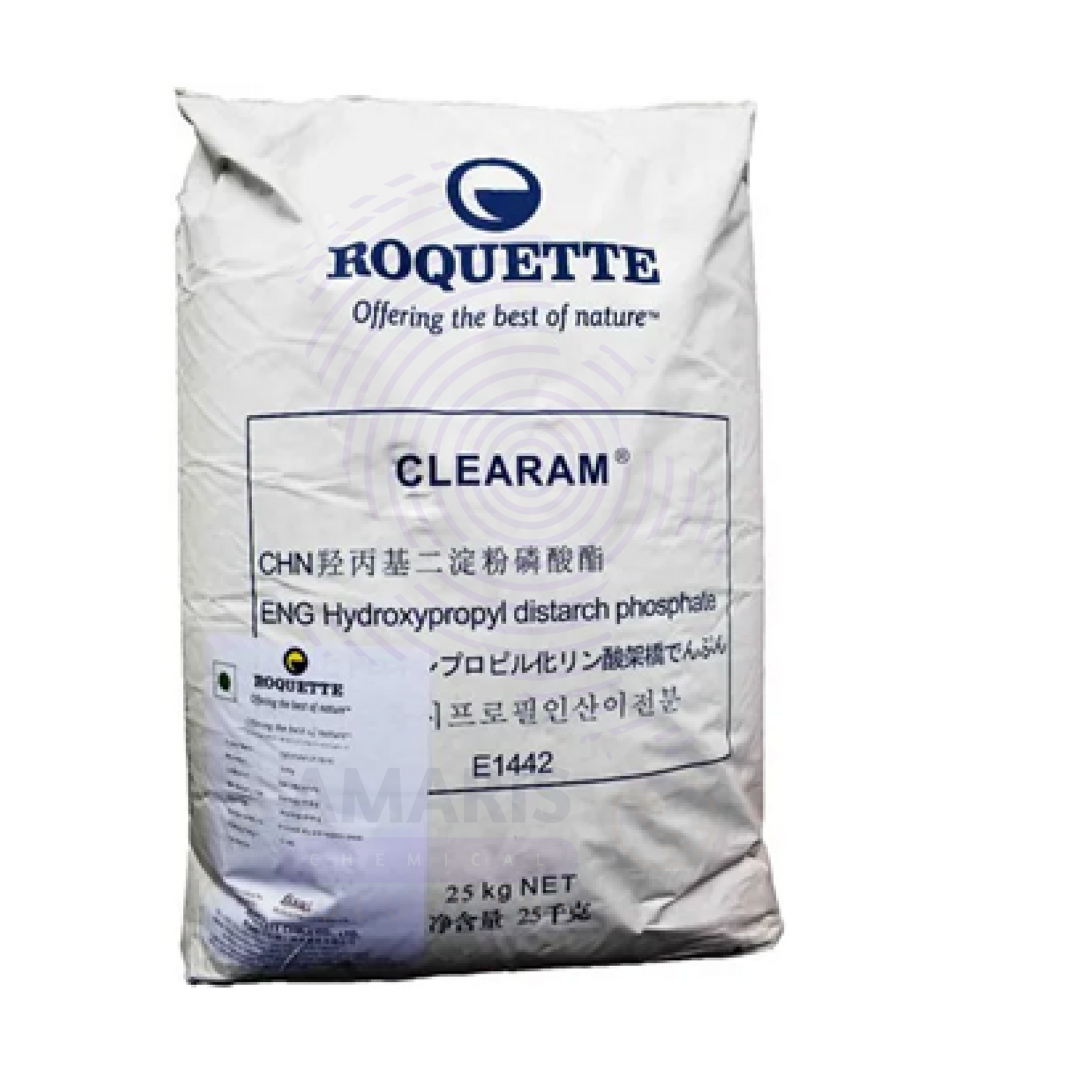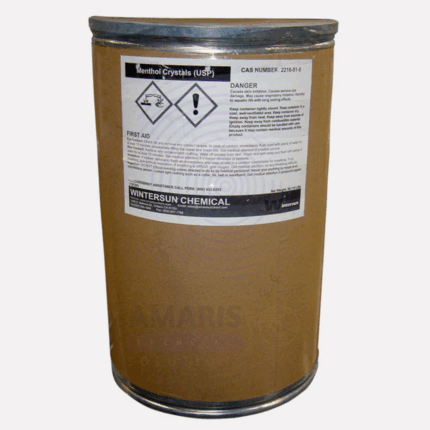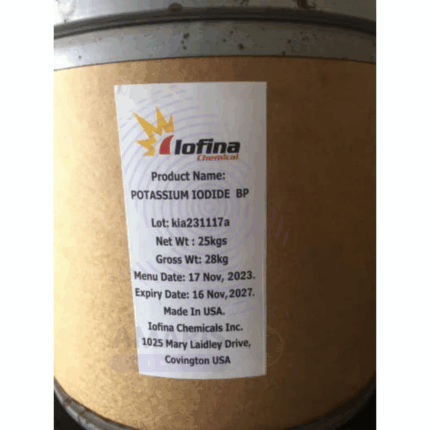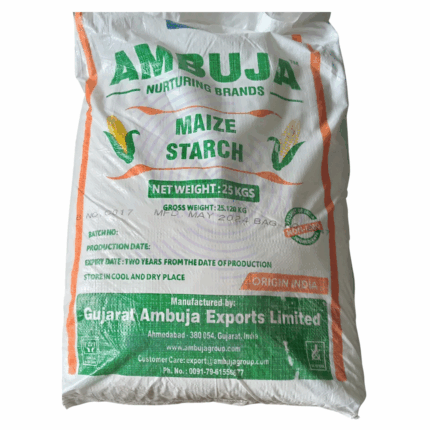Back to products
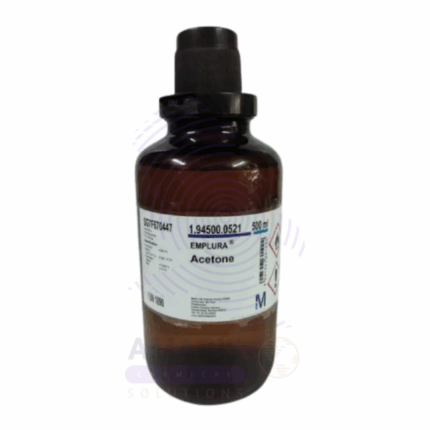

Acetone Extra Pure
$ 35.00 Original price was: $ 35.00.$ 34.89Current price is: $ 34.89.
Modified Starch Clearam
$ 4.40 Original price was: $ 4.40.$ 4.33Current price is: $ 4.33.
Whatsapp Order
Modified Starch Clearam is a chemically modified, food-grade starch designed to enhance texture, stability, and clarity in various food and industrial applications. It provides excellent thickening, gelling, and stabilizing properties, while maintaining clarity in finished products. The modification improves resistance to heat, acid, and shear, making it ideal for complex processing conditions. Clearam CH 4020 is widely used in processed foods, beverages, pharmaceuticals, and personal care products.
Description
Table of Contents
Toggle
Modified Starch Clearam
Primary Uses
- Food Industry
- Thickener and stabilizer in sauces, soups, gravies, and dressings.
- Improves texture and mouthfeel in dairy products such as yogurt and cream.
- Used in canned foods and ready meals to maintain consistency during processing and storage.
- Enhances clarity and viscosity in clear beverages and fruit juices.
- Baking and Confectionery
- Acts as a binder and moisture retainer in bakery fillings, icings, and confections.
- Provides freeze-thaw stability in frozen desserts and bakery goods.
- Pharmaceuticals
- Excipient in tablet formulations as a binder and disintegrant.
- Used in suspensions and syrups for viscosity control and stability.
Secondary Uses
- Personal Care Products
- Thickener and stabilizer in lotions, creams, and gels.
- Enhances texture and sensory feel in cosmetics and toiletries.
- Industrial Applications
- Used in paper coating formulations for improved surface properties.
- Employed in adhesives for controlled viscosity and film formation.
- Nutraceuticals
- Stabilizes liquid supplements and enhances bioavailability of active compounds.
KEY PRODUCT FEATURES
Basic Identification Attributes
- Chemical Name (IUPAC): Modified starch (hydroxypropylated or other substitution types)
- Common/Trade Name: Modified Starch Clearam CH 4020
- CAS Number: Typically mixture; depends on starch source
- HS Code: 3505.10 (Dextrins and other modified starches)
- Synonyms: Modified food starch; Clearam CH 4020
Physical & Chemical Properties
- Physical State: Fine powder
- Color & Odor: White to off-white; odorless or faint characteristic starch odor
- Solubility: Dispersible in cold water; forms clear gel upon heating
- Particle Size: Typically 10–50 microns
- Functional Properties: Heat stable, acid resistant, shear resistant
Safety & Hazard Attributes
- GHS Classification: Not classified as hazardous
- Toxicity: Generally recognized as safe (GRAS) for food and cosmetic use
- Exposure Limits: No specific limits; standard hygiene practices recommended
Storage & Handling Attributes
- Storage Conditions: Store in a cool, dry place away from moisture and contaminants
- Container Type: Supplied in kraft paper bags with polyethylene lining or bulk containers
- Shelf Life: Typically 12–24 months if stored properly
- Handling Precautions: Avoid dust formation; use dust masks if necessary
Regulatory & Compliance Attributes
- Complies with FDA food additive regulations (21 CFR)
- Meets Codex Alimentarius standards for modified starches
- Approved for use in EU, Japan, and other major markets
Environmental & Health Impact
- Biodegradability: Fully biodegradable, environmentally friendly
- Ecotoxicity: Low environmental impact
- Bioaccumulation: Not applicable
Carcinogenicity/Mutagenicity: Not classified as hazardous
SAFETY HANDLING PRECAUTIONS
Safety Handling Precautions
- PPE Required: Dust masks and gloves recommended during handling of powder
- Handling Guidelines: Use in well-ventilated areas; avoid inhalation of dust
- Storage Measures: Keep containers tightly closed; protect from moisture
First Aid Measures
- Inhalation: Move to fresh air if irritation occurs
- Skin Contact: Wash with soap and water if irritation develops
- Eye Contact: Rinse with water for at least 15 minutes; seek medical advice if irritation persists
- Ingestion: Generally safe; seek medical advice if large amounts ingested
Firefighting Measures
- Fire Hazards: Combustible dust; avoid dust cloud formation
- Extinguishing Media: Water spray, foam, dry chemical
- Special Precautions: Use breathing apparatus if dust is present
- Hazardous Combustion Products: Carbon oxides
Related products
Menthol crystals
Menthol Crystals are natural organic compounds derived from peppermint or other mint oils, presenting as clear or white crystalline solids with a strong, cooling mint aroma. They possess analgesic, antiseptic, and flavoring properties. Widely used in pharmaceuticals, cosmetics, food, and personal care products, menthol crystals provide a refreshing cooling sensation and fragrance, enhancing product efficacy and consumer appeal.
Methyl Cellulose 400mpc
Methyl Cellulose 400 MPC is a chemically modified cellulose derivative in powder form. It is a non-ionic, water-soluble polymer widely used as a thickener, binder, emulsifier, and film former. It exhibits excellent water retention, viscosity control, and thermal gelation properties, making it ideal for applications in construction, pharmaceuticals, food, and cosmetics.
Potassium Iodide
Potassium Iodide is a white, crystalline inorganic salt that serves as a vital source of iodine. It is widely used in medical, pharmaceutical, nutritional, and industrial fields. Potassium Iodide is highly soluble in water and is used both as a dietary supplement to prevent iodine deficiency and as a protective agent against radioactive iodine exposure. It also finds applications in chemical synthesis and photographic processes.
Potassium Lactate
Potassium Lactate is the potassium salt of lactic acid, typically available as a clear, colorless to pale yellow liquid or solid powder. It functions primarily as a food additive, humectant, and preservative with antimicrobial properties. Widely used in the food industry, it also finds applications in pharmaceuticals, cosmetics, and industrial processes. Potassium Lactate helps improve moisture retention, extend shelf life, and enhance safety by inhibiting microbial growth.
Povidone PVP25 USP
Povidone PVP25 USP is a synthetic polymer of vinylpyrrolidone with an average molecular weight of approximately 25,000. It is a water-soluble, non-toxic, and biodegradable polymer widely used as a binder, film former, stabilizer, and solubilizing agent in pharmaceutical, cosmetic, and industrial applications. Its excellent adhesive properties and compatibility with a wide range of substances make it essential in tablet formulations, topical products, and adhesives.
Pregelatinised Maize Starch
Pregelatinised Maize Starch is a modified starch derived from maize that has been pre-cooked and then dried. This process disrupts the crystalline structure, allowing it to absorb water and swell without the need for heating. It acts as an excellent binder, thickener, and disintegrant in various formulations, offering improved solubility and rapid hydration. Pregelatinised maize starch is widely used in pharmaceutical, food, and industrial applications due to its versatile functional properties.
Protease Baking enzymes
Protease Baking Enzymes are specialized enzymes that catalyze the breakdown of proteins into peptides and amino acids. In baking, these enzymes improve dough handling, texture, and volume by modifying gluten structure and enhancing gas retention. They help produce softer crumb, better crust, and increased shelf life of baked goods. Protease enzymes are essential for consistent quality and efficiency in commercial baking operations.
Pure Honey 30kg Jerrycan
Pure Honey is a natural sweetener produced by honeybees from the nectar of flowers. It is a viscous, golden liquid known for its sweetness, flavor complexity, and natural preservative qualities. Packed in 30kg jerrycans for bulk supply, pure honey is widely used in food, pharmaceutical, and cosmetic industries due to its nutritional benefits, antimicrobial properties, and versatility.


 Preservatives(food)
Preservatives(food) Flavor Enhancers
Flavor Enhancers Acidulants
Acidulants Sweeteners
Sweeteners Antioxidants
Antioxidants Colorants(food)
Colorants(food) Nutraceutical Ingredients (food)
Nutraceutical Ingredients (food) Nutrient Supplements
Nutrient Supplements Emulsifiers
Emulsifiers
 Collectors
Collectors Dust Suppressants
Dust Suppressants Explosives and Blasting Agents
Explosives and Blasting Agents Flocculants and Coagulants
Flocculants and Coagulants Frothers
Frothers Leaching Agents
Leaching Agents pH Modifiers
pH Modifiers Precious Metal Extraction Agents
Precious Metal Extraction Agents
 Antioxidants(plastic)
Antioxidants(plastic) Colorants (Pigments, Dyes)
Colorants (Pigments, Dyes) Fillers and Reinforcements
Fillers and Reinforcements Flame Retardants
Flame Retardants Monomers
Monomers Plasticizers
Plasticizers Polymerization Initiators
Polymerization Initiators Stabilizers (UV, Heat)
Stabilizers (UV, Heat)
 Antifoaming Agents
Antifoaming Agents Chelating Agents
Chelating Agents Coagulants and Flocculants
Coagulants and Flocculants Corrosion Inhibitors
Corrosion Inhibitors Disinfectants and Biocides
Disinfectants and Biocides Oxidizing Agents
Oxidizing Agents pH Adjusters
pH Adjusters Scale Inhibitors( water)
Scale Inhibitors( water)
 Antioxidants(cosmetic)
Antioxidants(cosmetic) Emollients
Emollients Fragrances and Essential Oils
Fragrances and Essential Oils Humectants
Humectants Preservatives
Preservatives Surfactants(cosmetic)
Surfactants(cosmetic) Thickeners
Thickeners UV Filters
UV Filters
 Fertilizers
Fertilizers Soil Conditioners
Soil Conditioners Plant Growth Regulators
Plant Growth Regulators Animal Feed Additives
Animal Feed Additives Biostimulants
Biostimulants Pesticides (Herbicides, Insecticides, Fungicides)
Pesticides (Herbicides, Insecticides, Fungicides)
 Active Pharmaceutical Ingredients (APIs)
Active Pharmaceutical Ingredients (APIs) Excipients
Excipients Solvents(pharmaceutical)
Solvents(pharmaceutical) Antibiotics
Antibiotics Antiseptics and Disinfectants
Antiseptics and Disinfectants Vaccine Adjuvants
Vaccine Adjuvants Nutraceutical Ingredients (pharmaceutical)
Nutraceutical Ingredients (pharmaceutical) Analgesics & Antipyretics
Analgesics & Antipyretics
 Analytical Reagents
Analytical Reagents Solvents(lab)
Solvents(lab) Chromatography Chemicals
Chromatography Chemicals Spectroscopy Reagents
Spectroscopy Reagents microbiology-and-cell-culture-reagents
microbiology-and-cell-culture-reagents Molecular Biology Reagents
Molecular Biology Reagents Biochemical Reagents
Biochemical Reagents Inorganic and Organic Standards
Inorganic and Organic Standards Laboratory Safety Chemicals
Laboratory Safety Chemicals Specialty Laboratory Chemicals(Special Laboratory Equipment)
Specialty Laboratory Chemicals(Special Laboratory Equipment)
 Demulsifiers
Demulsifiers Hydraulic Fracturing Fluids
Hydraulic Fracturing Fluids Scale Inhibitors(oil)
Scale Inhibitors(oil) Surfactants(oil)
Surfactants(oil) Drilling Fluids
Drilling Fluids
 Dyes and Pigments
Dyes and Pigments Bleaching Agents
Bleaching Agents Softening Agents
Softening Agents Finishing Agents
Finishing Agents Antistatic Agents
Antistatic Agents
 Admixtures
Admixtures Waterproofing Agents
Waterproofing Agents Sealants and Adhesives
Sealants and Adhesives Curing Compounds
Curing Compounds Concrete Repair Chemicals
Concrete Repair Chemicals Anti-Corrosion Coatings
Anti-Corrosion Coatings
 Surfactants(cleaning)
Surfactants(cleaning) Builders
Builders Enzymes
Enzymes Solvents (Cleaning)
Solvents (Cleaning) Fragrances
Fragrances
 Electronic Chemicals
Electronic Chemicals Catalysts
Catalysts Lubricants
Lubricants Photographic Chemicals
Photographic Chemicals Refrigerants
Refrigerants Automotive chemicals
Automotive chemicals Pyrotechnic Chemicals
Pyrotechnic Chemicals
 Biodegradable Surfactants
Biodegradable Surfactants Bio-based Solvents
Bio-based Solvents Renewable Polymers
Renewable Polymers Carbon Capture Chemicals
Carbon Capture Chemicals Wastewater Treatment Chemicals
Wastewater Treatment Chemicals
 Pigments
Pigments Solvents(paint)
Solvents(paint) Specialty Coatings
Specialty Coatings Binders/Resins
Binders/Resins Additives
Additives Driers
Driers Anti-Corrosion Agents
Anti-Corrosion Agents Functional Coatings
Functional Coatings Application-Specific Coatings
Application-Specific Coatings
 Fresh Herbs
Fresh Herbs Ground Spices
Ground Spices Whole Spices
Whole Spices Spice Blends
Spice Blends Dried Herbs
Dried Herbs
 Leavening Agents
Leavening Agents Dough Conditioners
Dough Conditioners Flour Treatments
Flour Treatments Fat Replacers
Fat Replacers Decoratives
Decoratives Preservatives(baking)
Preservatives(baking)
 Plasticizers & Softeners
Plasticizers & Softeners Reinforcing Agents
Reinforcing Agents Adhesion Promoters
Adhesion Promoters Vulcanizing Agents
Vulcanizing Agents Antidegradants
Antidegradants Blowing Agents
Blowing Agents Fillers & Extenders
Fillers & Extenders Accelerators & Retarders
Accelerators & Retarders